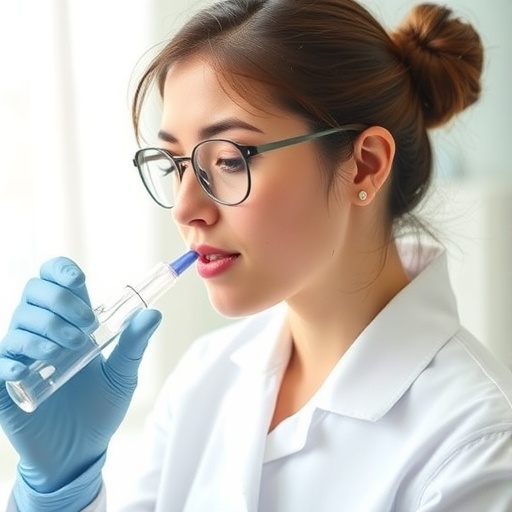In the realm of pharmacology and drug discovery, the quest for high oral bioavailability remains one of the most significant challenges facing researchers today. As the landscape of medicine evolves, so too does the need for innovative methods to predict how compounds will behave in the human body. Recent developments in this field have shown promise, particularly through the lens of transfer learning, a machine learning approach that utilizes the knowledge gained while solving one problem and applies it to a different but related problem. Such techniques can potentially decrease the time and resources required for drug development, making them invaluable in the pharmaceutical industry.
A recent study by Zeng, Xu, Liu, and their colleagues aims to explore the relationship between task similarity and the predictive accuracy of oral bioavailability. The core idea is that by leveraging transfer learning, researchers can tap into existing knowledge from various tasks to enhance predictions related to oral bioavailability properties of novel compounds. This study not only offers a fresh perspective on bioavailability prediction but also opens avenues for more sophisticated modeling techniques in pharmacokinetics.
Historically, predicting oral bioavailability has relied heavily on highly specialized computational models. These models often require extensive datasets and intricate feature engineering, which can be both resource-intensive and time-consuming. However, the advent of machine learning and deep learning has ushered a new era that promises to transform how these predictions are made. The intuitive nature of transfer learning, where models can refine their predictions based on previously acquired insights, stands at the forefront of these advances.
The researchers in this study utilized a variety of datasets encompassing numerous substances with known bioavailability profiles. By analyzing these datasets, they could identify similarities between tasks relevant to bioavailability prediction. These similarities acted as a bridge, allowing the transfer of learning parameters from one dataset to another. The results showed a significant increase in prediction accuracy, which is paramount in determining how effectively a drug will act in humans.
Incorporating task similarity into the predictive models underscored a major breakthrough: improving model performance without requiring exponentially larger datasets or more complex computational power. By employing transfer learning, the researchers could significantly reduce the noise associated with data collection errors, offering a more refined pathway toward understanding drug absorption and distribution in the body. This advancement not only has implications for drug efficacy but also for addressing public health concerns where timely accessibility to effective treatments is critical.
One of the most compelling aspects of the study was its emphasis on generalizability. The researchers demonstrated that their model could be applicable across a broad range of chemical compounds, thus solidifying its relevance in real-world applications. Their approach could be particularly beneficial in the early stages of drug discovery when preliminary data may be sparse but insights gleaned from related compounds are abundant. This could facilitate a more robust screening process that efficiently narrows down potential therapeutic candidates.
Furthermore, this study encourages collaboration across disciplines. The intersection of computational biology, machine learning, and pharmacology inherent in this research illustrates the power of interdisciplinary approaches. By uniting experts from various fields, the touchpoint for innovation is broadened, enhancing the scope and impact of findings. Such collaborations can lead to the formation of new methodologies that offer more accurate predictions in drug development and personalized medicine.
As we stand on the cusp of what might be viewed as a revolution in drug bioavailability prediction, industries will need to adapt rapidly. The pharmaceutical industry operates at an incredibly fast pace, and the ability to adopt cutting-edge technologies such as those presented by Zeng and colleagues will be a defining factor in future successes. The insights gained from this study illuminate the path forward—promising more effective and safer therapeutic options for patients globally.
Additionally, the implementation of such predictive models doesn’t stop at the lab bench. Regulatory bodies will likely benefit from these advancements, as improved prediction models could streamline necessary evaluations for drug approval. As the industry continues to grapple with stringent regulatory requirements, accurate and efficient bioavailability predictions could very well lead to shorter timelines for getting effective medications into patients’ hands.
However, while the possibilities are exhilarating, challenges remain. The research community must approach transfer learning with a level of caution, ensuring that the predictive models remain transparent and interpretable. As these techniques evolve, maintaining an ethical framework for how predictions are made will be crucial in fostering trust within the medical community and among patients themselves.
In summary, the intersection of task similarity and transfer learning presents an exceptional opportunity to revolutionize the way oral bioavailability is predicted. Zeng et al. have laid the groundwork for future inquiries that might prove essential not only for drug development but also for enhancing methodologies across various scientific arenas. The implications of their findings are substantial, indicating a potential shift in how predictive modeling will be conducted moving forward, ultimately leading us closer to realizing the dream of personalized medicine.
As we look to the future, the integration of technological advancements in drug discovery could pave the way for innovative therapeutics that are efficiently developed and readily accessible. The journey that began with identifying the task similarities in bioavailability studies now holds the promise of reshaping our understanding and approaches to drug design, mirroring the inherent complexities of human biology with a greater finesse than ever before.
This research marks a significant milestone in drug bioavailability studies and represents a pivotal step toward making the drug development process faster, more efficient, and more reliable.
Subject of Research: Oral bioavailability property prediction using transfer learning techniques
Tags: computational models in drug researchenhancing drug development efficiencyinnovative methods in medicinemachine learning for drug discoverynovel compounds bioavailabilityoral bioavailability predictionpharmaceutical industry advancementspredictive modeling in pharmacokineticsreducing drug development resourcesrelationship between task similarity and accuracysophisticated modeling techniques in pharmacologytransfer learning in pharmacology





